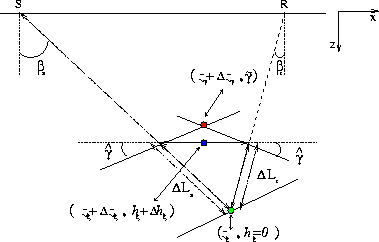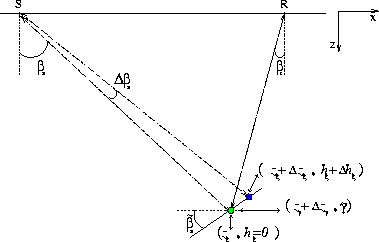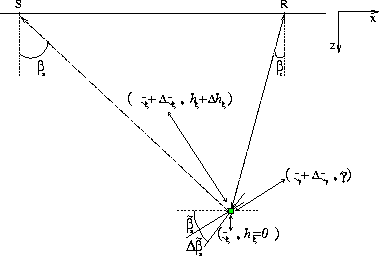The geometric interpretation of the angle-domain transformation kinematics allows us to simplify equation (21) by showing that the terms multiplying the partial derivatives with respect to the angles are zero. Equation (21) simplifies to
| |
(22) |
Linearized perturbations caused by changes in L
Figure 5 graphically illustrates the image perturbation related to the first term in equation (22). It shows the movement of the image points (both in the subsurface-offset domain and the angle domain) caused by changes in the ray length L.
|
cig-2d-aniso-delta1-dipping-1
Figure 5 Linearized perturbations of the image-point locations caused by changes in the ray length L. |  |
Linearized perturbations caused by changes in ![]()
Figure 6 graphically
illustrates the image perturbation related to the second term in
equation (22). Perturbations in the angle ![]() cause the subsurface offset-domain image to move along the tangent to
the incident wavefront. Since this movement is constraint along the
tangent, the image point in the angle-domain does not move no matter
how large the corresponding movement in the subsurface offset domain
is.
cause the subsurface offset-domain image to move along the tangent to
the incident wavefront. Since this movement is constraint along the
tangent, the image point in the angle-domain does not move no matter
how large the corresponding movement in the subsurface offset domain
is.
|
cig-2d-aniso-delta2-dipping-1
Figure 6 Linearized perturbations of the image-point locations caused by changes in |  |
Linearized perturbations caused by changes in 
Figure 7 graphically
illustrates the image perturbation related to the third term in
equation (22). Since we linearize the depth of
the image point around the correct migration velocity function,
perturbations in the angle  don't affect the depth
of the imaging point (it is the main concept of ADCIGs).
don't affect the depth
of the imaging point (it is the main concept of ADCIGs).
|
cig-2d-aniso-delta3-dipping-1
Figure 7 Linearized perturbations of the image-point locations caused by changes in  . . |  |